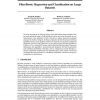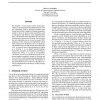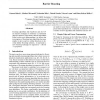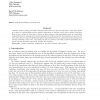COLT
2000
Springer
14 years 6 months ago
2000
Springer
In the present paper, we present the theoretical basis, as well as an empirical validation, of a protocol designed to obtain effective VC dimension estimations in the case of a si...
COLT
2000
Springer
14 years 6 months ago
2000
Springer
In this paper we examine master regression algorithms that leverage base regressors by iteratively calling them on modified samples. The most successful leveraging algorithm for c...
COLT
2000
Springer
14 years 6 months ago
2000
Springer
COLT
2000
Springer
14 years 6 months ago
2000
Springer
This paper collects together a miscellany of results originally motivated by the analysis of the generalization performance of the “maximum-margin” algorithm due to Vapnik and...
COLT
2000
Springer
14 years 6 months ago
2000
Springer
The present paper deals with the averagecase complexity of various algorithms for learning univariate polynomials. For this purpose an appropriate framework is introduced. Based o...
COLT
2000
Springer
14 years 6 months ago
2000
Springer
We describe a novel family of PAC model algorithms for learning linear threshold functions. The new algorithms work by boosting a simple weak learner and exhibit complexity bounds...
COLT
2000
Springer
14 years 6 months ago
2000
Springer
Boosting algorithms like AdaBoost and Arc-GV are iterative strategies to minimize a constrained objective function, equivalent to Barrier algorithms. Based on this new understandi...
COLT
2000
Springer
14 years 6 months ago
2000
Springer
Good-Turing adjustments of word frequencies are an important tool in natural language modeling. In particular, for any sample of words, there is a set of words not occuring in tha...
COLT
2000
Springer
14 years 6 months ago
2000
Springer
COLT
2000
Springer
14 years 6 months ago
2000
Springer
Haussler, Kearns, Seung and Tishby introduced the notion of a shell decomposition of the union bound as a means of understanding certain empirical phenomena in learning curves suc...




